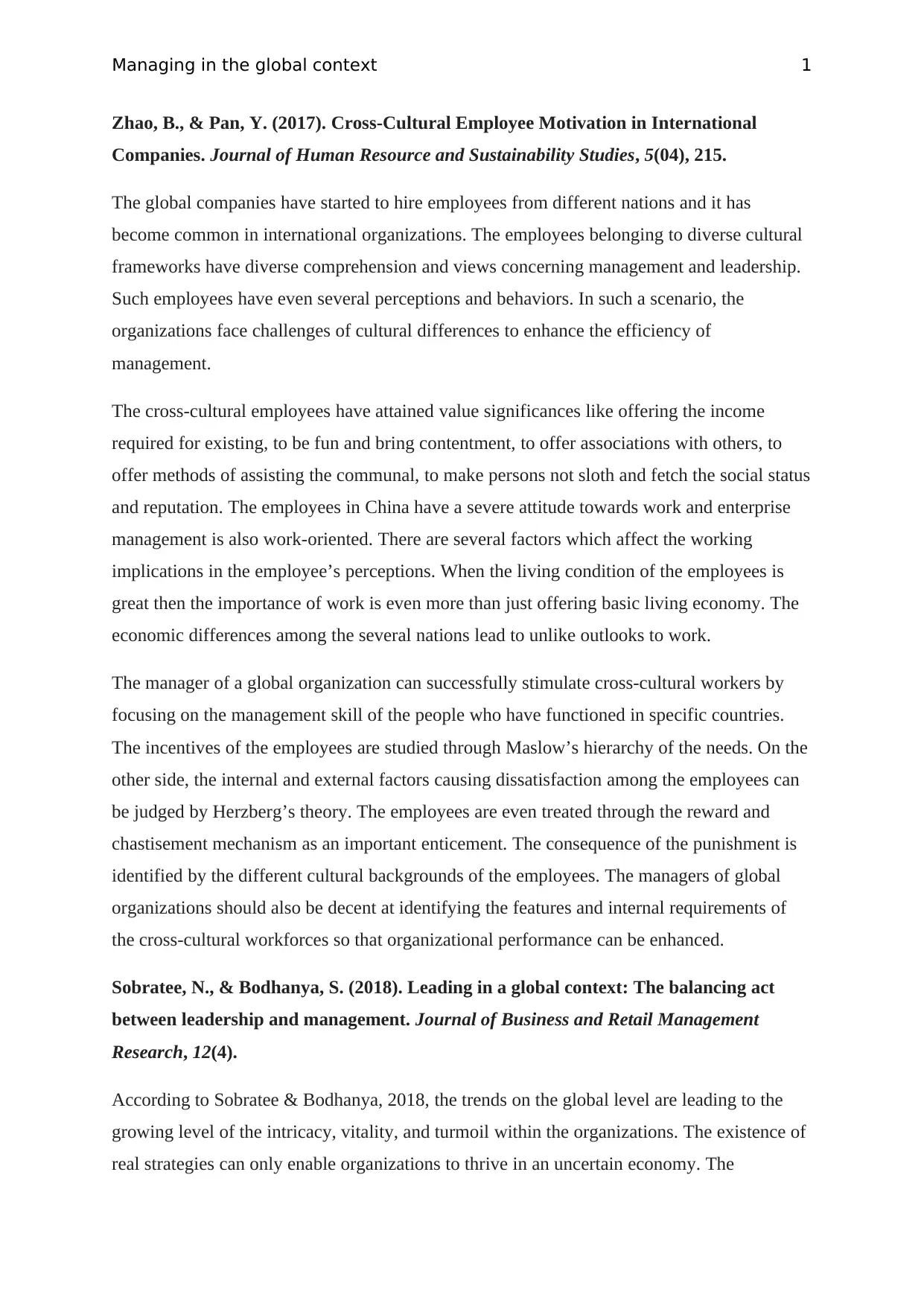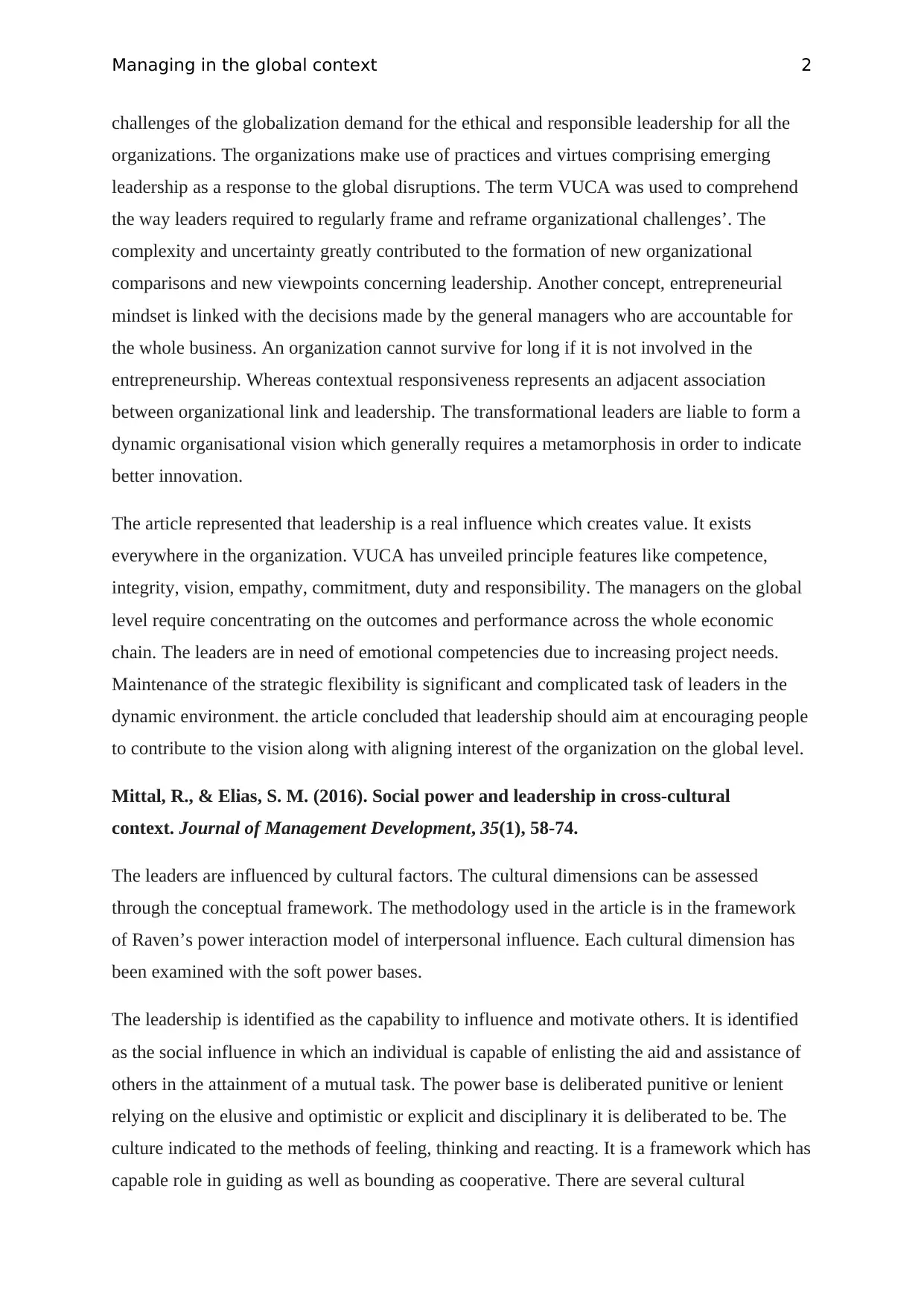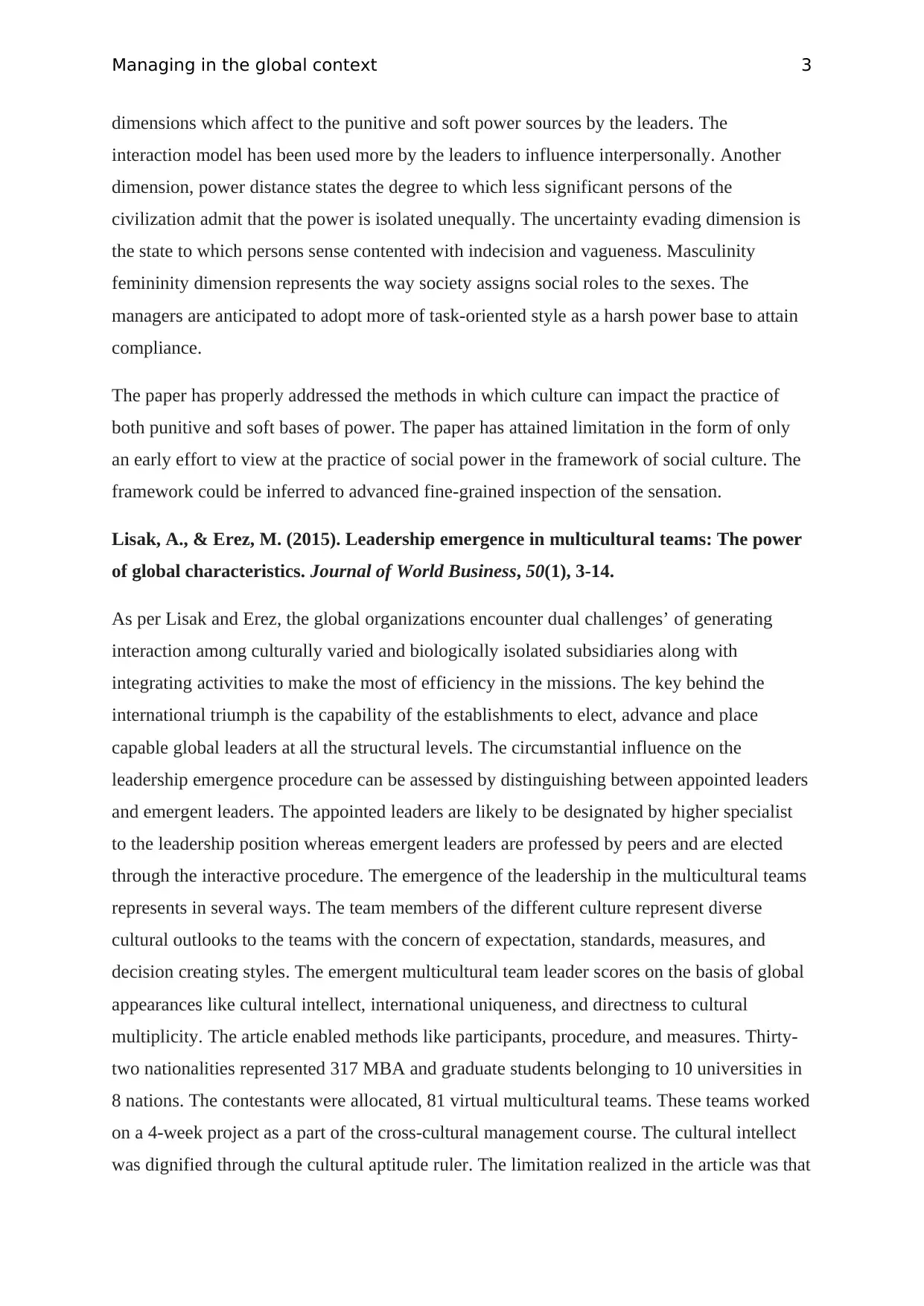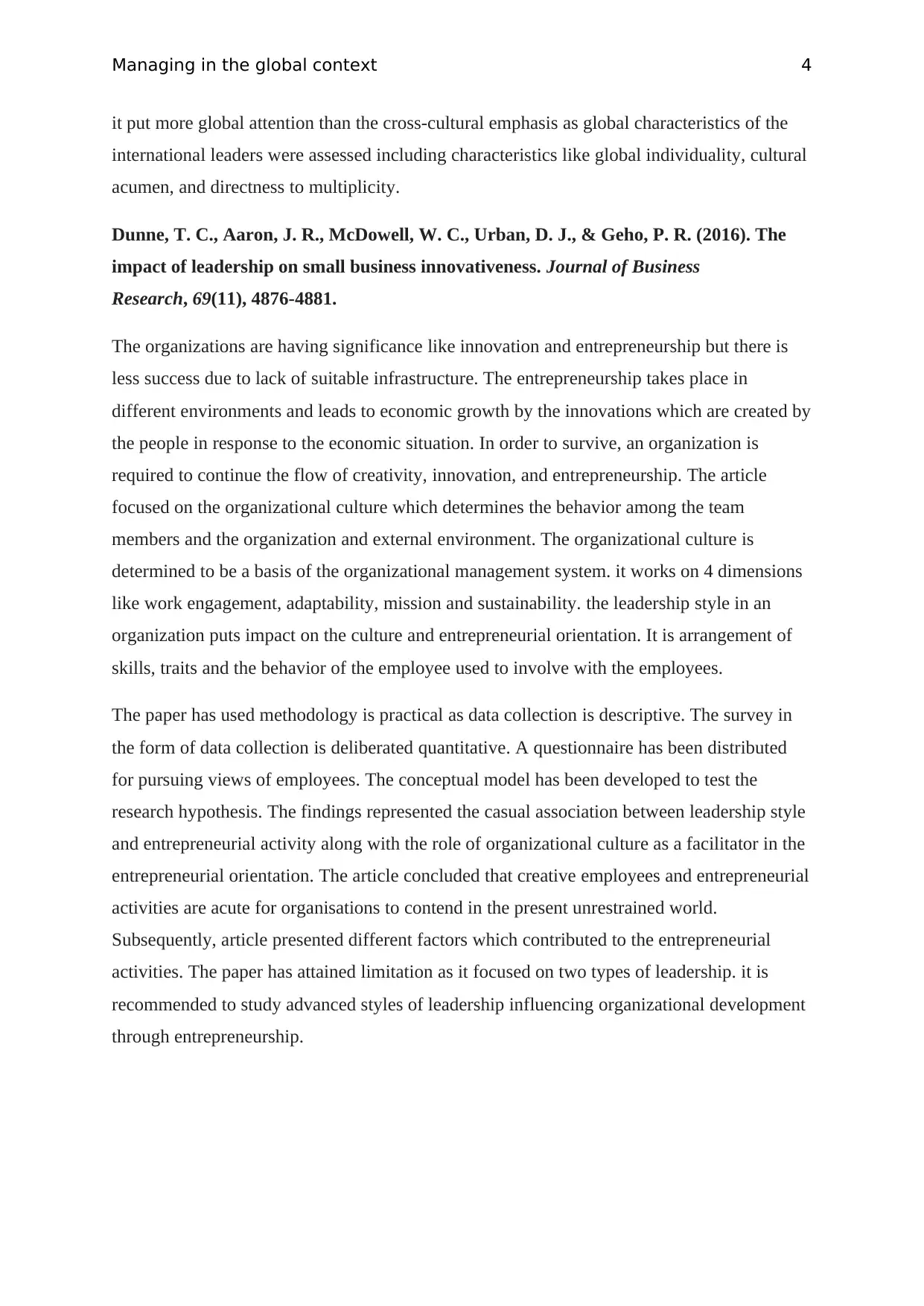MGT604 Individual Annotated Bibliography: Global Context Analysis
VerifiedAdded on 2022/11/28
|5
|1736
|54
Report
AI Summary
This report presents an annotated bibliography on managing in a global context, analyzing five research-based academic journal articles. The articles explore various aspects of global management, including cross-cultural employee motivation, leadership in a global context, the influence of cultural factors on leadership, leadership emergence in multicultural teams, and the impact of leadership on small business innovativeness. The report summarizes each article, outlining its relevance to the field, the research methods employed (including sample sizes and data collection), key findings, and implications for managers. The analysis covers topics such as cultural differences in employee perceptions, the importance of ethical and responsible leadership, the impact of cultural dimensions on leadership styles, the challenges of leading multicultural teams, and the role of leadership in fostering innovation and entrepreneurship. The report emphasizes the importance of adapting leadership approaches to effectively manage diverse workforces and navigate the complexities of the global business environment.

Managing in the global context
Paraphrase This Document
Need a fresh take? Get an instant paraphrase of this document with our AI Paraphraser

Managing in the global context 1
Zhao, B., & Pan, Y. (2017). Cross-Cultural Employee Motivation in International
Companies. Journal of Human Resource and Sustainability Studies, 5(04), 215.
The global companies have started to hire employees from different nations and it has
become common in international organizations. The employees belonging to diverse cultural
frameworks have diverse comprehension and views concerning management and leadership.
Such employees have even several perceptions and behaviors. In such a scenario, the
organizations face challenges of cultural differences to enhance the efficiency of
management.
The cross-cultural employees have attained value significances like offering the income
required for existing, to be fun and bring contentment, to offer associations with others, to
offer methods of assisting the communal, to make persons not sloth and fetch the social status
and reputation. The employees in China have a severe attitude towards work and enterprise
management is also work-oriented. There are several factors which affect the working
implications in the employee’s perceptions. When the living condition of the employees is
great then the importance of work is even more than just offering basic living economy. The
economic differences among the several nations lead to unlike outlooks to work.
The manager of a global organization can successfully stimulate cross-cultural workers by
focusing on the management skill of the people who have functioned in specific countries.
The incentives of the employees are studied through Maslow’s hierarchy of the needs. On the
other side, the internal and external factors causing dissatisfaction among the employees can
be judged by Herzberg’s theory. The employees are even treated through the reward and
chastisement mechanism as an important enticement. The consequence of the punishment is
identified by the different cultural backgrounds of the employees. The managers of global
organizations should also be decent at identifying the features and internal requirements of
the cross-cultural workforces so that organizational performance can be enhanced.
Sobratee, N., & Bodhanya, S. (2018). Leading in a global context: The balancing act
between leadership and management. Journal of Business and Retail Management
Research, 12(4).
According to Sobratee & Bodhanya, 2018, the trends on the global level are leading to the
growing level of the intricacy, vitality, and turmoil within the organizations. The existence of
real strategies can only enable organizations to thrive in an uncertain economy. The
Zhao, B., & Pan, Y. (2017). Cross-Cultural Employee Motivation in International
Companies. Journal of Human Resource and Sustainability Studies, 5(04), 215.
The global companies have started to hire employees from different nations and it has
become common in international organizations. The employees belonging to diverse cultural
frameworks have diverse comprehension and views concerning management and leadership.
Such employees have even several perceptions and behaviors. In such a scenario, the
organizations face challenges of cultural differences to enhance the efficiency of
management.
The cross-cultural employees have attained value significances like offering the income
required for existing, to be fun and bring contentment, to offer associations with others, to
offer methods of assisting the communal, to make persons not sloth and fetch the social status
and reputation. The employees in China have a severe attitude towards work and enterprise
management is also work-oriented. There are several factors which affect the working
implications in the employee’s perceptions. When the living condition of the employees is
great then the importance of work is even more than just offering basic living economy. The
economic differences among the several nations lead to unlike outlooks to work.
The manager of a global organization can successfully stimulate cross-cultural workers by
focusing on the management skill of the people who have functioned in specific countries.
The incentives of the employees are studied through Maslow’s hierarchy of the needs. On the
other side, the internal and external factors causing dissatisfaction among the employees can
be judged by Herzberg’s theory. The employees are even treated through the reward and
chastisement mechanism as an important enticement. The consequence of the punishment is
identified by the different cultural backgrounds of the employees. The managers of global
organizations should also be decent at identifying the features and internal requirements of
the cross-cultural workforces so that organizational performance can be enhanced.
Sobratee, N., & Bodhanya, S. (2018). Leading in a global context: The balancing act
between leadership and management. Journal of Business and Retail Management
Research, 12(4).
According to Sobratee & Bodhanya, 2018, the trends on the global level are leading to the
growing level of the intricacy, vitality, and turmoil within the organizations. The existence of
real strategies can only enable organizations to thrive in an uncertain economy. The

Managing in the global context 2
challenges of the globalization demand for the ethical and responsible leadership for all the
organizations. The organizations make use of practices and virtues comprising emerging
leadership as a response to the global disruptions. The term VUCA was used to comprehend
the way leaders required to regularly frame and reframe organizational challenges’. The
complexity and uncertainty greatly contributed to the formation of new organizational
comparisons and new viewpoints concerning leadership. Another concept, entrepreneurial
mindset is linked with the decisions made by the general managers who are accountable for
the whole business. An organization cannot survive for long if it is not involved in the
entrepreneurship. Whereas contextual responsiveness represents an adjacent association
between organizational link and leadership. The transformational leaders are liable to form a
dynamic organisational vision which generally requires a metamorphosis in order to indicate
better innovation.
The article represented that leadership is a real influence which creates value. It exists
everywhere in the organization. VUCA has unveiled principle features like competence,
integrity, vision, empathy, commitment, duty and responsibility. The managers on the global
level require concentrating on the outcomes and performance across the whole economic
chain. The leaders are in need of emotional competencies due to increasing project needs.
Maintenance of the strategic flexibility is significant and complicated task of leaders in the
dynamic environment. the article concluded that leadership should aim at encouraging people
to contribute to the vision along with aligning interest of the organization on the global level.
Mittal, R., & Elias, S. M. (2016). Social power and leadership in cross-cultural
context. Journal of Management Development, 35(1), 58-74.
The leaders are influenced by cultural factors. The cultural dimensions can be assessed
through the conceptual framework. The methodology used in the article is in the framework
of Raven’s power interaction model of interpersonal influence. Each cultural dimension has
been examined with the soft power bases.
The leadership is identified as the capability to influence and motivate others. It is identified
as the social influence in which an individual is capable of enlisting the aid and assistance of
others in the attainment of a mutual task. The power base is deliberated punitive or lenient
relying on the elusive and optimistic or explicit and disciplinary it is deliberated to be. The
culture indicated to the methods of feeling, thinking and reacting. It is a framework which has
capable role in guiding as well as bounding as cooperative. There are several cultural
challenges of the globalization demand for the ethical and responsible leadership for all the
organizations. The organizations make use of practices and virtues comprising emerging
leadership as a response to the global disruptions. The term VUCA was used to comprehend
the way leaders required to regularly frame and reframe organizational challenges’. The
complexity and uncertainty greatly contributed to the formation of new organizational
comparisons and new viewpoints concerning leadership. Another concept, entrepreneurial
mindset is linked with the decisions made by the general managers who are accountable for
the whole business. An organization cannot survive for long if it is not involved in the
entrepreneurship. Whereas contextual responsiveness represents an adjacent association
between organizational link and leadership. The transformational leaders are liable to form a
dynamic organisational vision which generally requires a metamorphosis in order to indicate
better innovation.
The article represented that leadership is a real influence which creates value. It exists
everywhere in the organization. VUCA has unveiled principle features like competence,
integrity, vision, empathy, commitment, duty and responsibility. The managers on the global
level require concentrating on the outcomes and performance across the whole economic
chain. The leaders are in need of emotional competencies due to increasing project needs.
Maintenance of the strategic flexibility is significant and complicated task of leaders in the
dynamic environment. the article concluded that leadership should aim at encouraging people
to contribute to the vision along with aligning interest of the organization on the global level.
Mittal, R., & Elias, S. M. (2016). Social power and leadership in cross-cultural
context. Journal of Management Development, 35(1), 58-74.
The leaders are influenced by cultural factors. The cultural dimensions can be assessed
through the conceptual framework. The methodology used in the article is in the framework
of Raven’s power interaction model of interpersonal influence. Each cultural dimension has
been examined with the soft power bases.
The leadership is identified as the capability to influence and motivate others. It is identified
as the social influence in which an individual is capable of enlisting the aid and assistance of
others in the attainment of a mutual task. The power base is deliberated punitive or lenient
relying on the elusive and optimistic or explicit and disciplinary it is deliberated to be. The
culture indicated to the methods of feeling, thinking and reacting. It is a framework which has
capable role in guiding as well as bounding as cooperative. There are several cultural
⊘ This is a preview!⊘
Do you want full access?
Subscribe today to unlock all pages.

Trusted by 1+ million students worldwide

Managing in the global context 3
dimensions which affect to the punitive and soft power sources by the leaders. The
interaction model has been used more by the leaders to influence interpersonally. Another
dimension, power distance states the degree to which less significant persons of the
civilization admit that the power is isolated unequally. The uncertainty evading dimension is
the state to which persons sense contented with indecision and vagueness. Masculinity
femininity dimension represents the way society assigns social roles to the sexes. The
managers are anticipated to adopt more of task-oriented style as a harsh power base to attain
compliance.
The paper has properly addressed the methods in which culture can impact the practice of
both punitive and soft bases of power. The paper has attained limitation in the form of only
an early effort to view at the practice of social power in the framework of social culture. The
framework could be inferred to advanced fine-grained inspection of the sensation.
Lisak, A., & Erez, M. (2015). Leadership emergence in multicultural teams: The power
of global characteristics. Journal of World Business, 50(1), 3-14.
As per Lisak and Erez, the global organizations encounter dual challenges’ of generating
interaction among culturally varied and biologically isolated subsidiaries along with
integrating activities to make the most of efficiency in the missions. The key behind the
international triumph is the capability of the establishments to elect, advance and place
capable global leaders at all the structural levels. The circumstantial influence on the
leadership emergence procedure can be assessed by distinguishing between appointed leaders
and emergent leaders. The appointed leaders are likely to be designated by higher specialist
to the leadership position whereas emergent leaders are professed by peers and are elected
through the interactive procedure. The emergence of the leadership in the multicultural teams
represents in several ways. The team members of the different culture represent diverse
cultural outlooks to the teams with the concern of expectation, standards, measures, and
decision creating styles. The emergent multicultural team leader scores on the basis of global
appearances like cultural intellect, international uniqueness, and directness to cultural
multiplicity. The article enabled methods like participants, procedure, and measures. Thirty-
two nationalities represented 317 MBA and graduate students belonging to 10 universities in
8 nations. The contestants were allocated, 81 virtual multicultural teams. These teams worked
on a 4-week project as a part of the cross-cultural management course. The cultural intellect
was dignified through the cultural aptitude ruler. The limitation realized in the article was that
dimensions which affect to the punitive and soft power sources by the leaders. The
interaction model has been used more by the leaders to influence interpersonally. Another
dimension, power distance states the degree to which less significant persons of the
civilization admit that the power is isolated unequally. The uncertainty evading dimension is
the state to which persons sense contented with indecision and vagueness. Masculinity
femininity dimension represents the way society assigns social roles to the sexes. The
managers are anticipated to adopt more of task-oriented style as a harsh power base to attain
compliance.
The paper has properly addressed the methods in which culture can impact the practice of
both punitive and soft bases of power. The paper has attained limitation in the form of only
an early effort to view at the practice of social power in the framework of social culture. The
framework could be inferred to advanced fine-grained inspection of the sensation.
Lisak, A., & Erez, M. (2015). Leadership emergence in multicultural teams: The power
of global characteristics. Journal of World Business, 50(1), 3-14.
As per Lisak and Erez, the global organizations encounter dual challenges’ of generating
interaction among culturally varied and biologically isolated subsidiaries along with
integrating activities to make the most of efficiency in the missions. The key behind the
international triumph is the capability of the establishments to elect, advance and place
capable global leaders at all the structural levels. The circumstantial influence on the
leadership emergence procedure can be assessed by distinguishing between appointed leaders
and emergent leaders. The appointed leaders are likely to be designated by higher specialist
to the leadership position whereas emergent leaders are professed by peers and are elected
through the interactive procedure. The emergence of the leadership in the multicultural teams
represents in several ways. The team members of the different culture represent diverse
cultural outlooks to the teams with the concern of expectation, standards, measures, and
decision creating styles. The emergent multicultural team leader scores on the basis of global
appearances like cultural intellect, international uniqueness, and directness to cultural
multiplicity. The article enabled methods like participants, procedure, and measures. Thirty-
two nationalities represented 317 MBA and graduate students belonging to 10 universities in
8 nations. The contestants were allocated, 81 virtual multicultural teams. These teams worked
on a 4-week project as a part of the cross-cultural management course. The cultural intellect
was dignified through the cultural aptitude ruler. The limitation realized in the article was that
Paraphrase This Document
Need a fresh take? Get an instant paraphrase of this document with our AI Paraphraser

Managing in the global context 4
it put more global attention than the cross-cultural emphasis as global characteristics of the
international leaders were assessed including characteristics like global individuality, cultural
acumen, and directness to multiplicity.
Dunne, T. C., Aaron, J. R., McDowell, W. C., Urban, D. J., & Geho, P. R. (2016). The
impact of leadership on small business innovativeness. Journal of Business
Research, 69(11), 4876-4881.
The organizations are having significance like innovation and entrepreneurship but there is
less success due to lack of suitable infrastructure. The entrepreneurship takes place in
different environments and leads to economic growth by the innovations which are created by
the people in response to the economic situation. In order to survive, an organization is
required to continue the flow of creativity, innovation, and entrepreneurship. The article
focused on the organizational culture which determines the behavior among the team
members and the organization and external environment. The organizational culture is
determined to be a basis of the organizational management system. it works on 4 dimensions
like work engagement, adaptability, mission and sustainability. the leadership style in an
organization puts impact on the culture and entrepreneurial orientation. It is arrangement of
skills, traits and the behavior of the employee used to involve with the employees.
The paper has used methodology is practical as data collection is descriptive. The survey in
the form of data collection is deliberated quantitative. A questionnaire has been distributed
for pursuing views of employees. The conceptual model has been developed to test the
research hypothesis. The findings represented the casual association between leadership style
and entrepreneurial activity along with the role of organizational culture as a facilitator in the
entrepreneurial orientation. The article concluded that creative employees and entrepreneurial
activities are acute for organisations to contend in the present unrestrained world.
Subsequently, article presented different factors which contributed to the entrepreneurial
activities. The paper has attained limitation as it focused on two types of leadership. it is
recommended to study advanced styles of leadership influencing organizational development
through entrepreneurship.
it put more global attention than the cross-cultural emphasis as global characteristics of the
international leaders were assessed including characteristics like global individuality, cultural
acumen, and directness to multiplicity.
Dunne, T. C., Aaron, J. R., McDowell, W. C., Urban, D. J., & Geho, P. R. (2016). The
impact of leadership on small business innovativeness. Journal of Business
Research, 69(11), 4876-4881.
The organizations are having significance like innovation and entrepreneurship but there is
less success due to lack of suitable infrastructure. The entrepreneurship takes place in
different environments and leads to economic growth by the innovations which are created by
the people in response to the economic situation. In order to survive, an organization is
required to continue the flow of creativity, innovation, and entrepreneurship. The article
focused on the organizational culture which determines the behavior among the team
members and the organization and external environment. The organizational culture is
determined to be a basis of the organizational management system. it works on 4 dimensions
like work engagement, adaptability, mission and sustainability. the leadership style in an
organization puts impact on the culture and entrepreneurial orientation. It is arrangement of
skills, traits and the behavior of the employee used to involve with the employees.
The paper has used methodology is practical as data collection is descriptive. The survey in
the form of data collection is deliberated quantitative. A questionnaire has been distributed
for pursuing views of employees. The conceptual model has been developed to test the
research hypothesis. The findings represented the casual association between leadership style
and entrepreneurial activity along with the role of organizational culture as a facilitator in the
entrepreneurial orientation. The article concluded that creative employees and entrepreneurial
activities are acute for organisations to contend in the present unrestrained world.
Subsequently, article presented different factors which contributed to the entrepreneurial
activities. The paper has attained limitation as it focused on two types of leadership. it is
recommended to study advanced styles of leadership influencing organizational development
through entrepreneurship.
1 out of 5
Related Documents
Your All-in-One AI-Powered Toolkit for Academic Success.
+13062052269
info@desklib.com
Available 24*7 on WhatsApp / Email
![[object Object]](/_next/static/media/star-bottom.7253800d.svg)
Unlock your academic potential
Copyright © 2020–2025 A2Z Services. All Rights Reserved. Developed and managed by ZUCOL.





